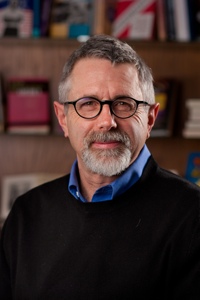An SJMC professor and colleagues across the country are looking forward to 2042 and imagining how communities will meet the information needs of citizens, in a broad range from making emergency police calls to finding a job to finding local well baby care and finding the local civic and political information necessary for full democratic participation.
The American public has measurable and unmet information needs at both the individual and community levels, according to a report presented to the FCC in Washington Tuesday, June 26.
 Lew Friedland, SJMC professor and Director of the Center for Communication and Democracy, was co-Principal Investigator and lead author of the report with Dean Ernest Wilson of the USC Annenberg School and Professor Phil Napoli of Fordham University. Video of their FCC presentation is available online, as is the executive summary. The full report and bibliography will be available mid-July.
Lew Friedland, SJMC professor and Director of the Center for Communication and Democracy, was co-Principal Investigator and lead author of the report with Dean Ernest Wilson of the USC Annenberg School and Professor Phil Napoli of Fordham University. Video of their FCC presentation is available online, as is the executive summary. The full report and bibliography will be available mid-July.
Associate Dean Carola Weil and Ph.D.student Katya Ognyanova of Annenberg were co-authors. SJMC Ph.D.students Sandra Knisely and Matthew Barnidge were lead research assistants, along with Seomin Soo of Columbia.
The report comprehensively reviewed literature on community information needs in eight areas: emergency and risk communication, health, education, economic opportunity, the environment, transportation, civic and political life. It concluded that while some research on information needs in these areas exists, there is not sufficient work to demonstrate whether and how the needs are being met, and that the preponderance of evidence points to major gaps. The report focused on the diverse needs of Americans in a rapidly changing society, stressing that by 2042 the U.S. will no longer be a country divided into a “majority” and “minorities” but a truly plural nation.
The report was commissioned “to examine existing research into the critical information needs of the American public and market-entry barriers into participation in the communication industry,” according to the FCC. “The research will inform the Commission’s 2012 Report to Congress about barriers to participation in the communications industry, also known as the Section 257 Report.”
Friedland co-led the research team with significant participation from other UW SJMC faculty and students. Professors Shawnika Hull (health), Hernando Rojas (diversity, methods, civic life), Dhavan Shah (political communication, methods) and Hemant Shah (diversity) were key members of the national Communications Policy Research Network formed to generate the initial pool of more than 1000 peer-reviewed sources reviewed for the report. These were winnowed to just under 500 for a final annotated bibliography. Professor Katy Culver, (health and new media), UW Ph.D. students Jackson Foote, Nakho Kim, Magda Konieczna, Mitchell Schwartz, Manisha Shelat contributed to research on the bibliography.
The team’s recommendations are:
To fulfill FCC’s statutory mission, we need to investigate whether and how local information needs are met, which is the critical first step to understanding how markets, government policies and individual and group actions can meet the information needs of their communities.
Take into account variations within communities and specific populations in studying critical information needs – Look to America of 2042.
Incorporate into analysis the exponentially growing costs of network exclusion and increasingly complex functioning of local media systems.
Complement existing econometric analyses with additional analytic models such as a communication ecological approach (multilevel/multi‐method); aim to be valid, replicable and parsimonious.
Develop robust, testable indicators of performance for policy- and community‐relevant evaluation.
They will submit a final version of the report after receiving FCC and public comments.
This project builds in part on a Knight Foundation-funded workshop held at USC Annenberg in January about redefining diversity in a digital age.

